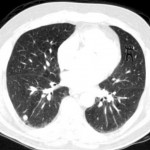Earlier this week, NPR ran a story about some interesting research into the concept of inattential blindness that I think is incredibly instructive for arts leaders. The study went like this: an image of a man in a gorilla suit was superimposed upon a series of slides that radiologists typically use to look for cancer (see the image to the left). A group of radiologists were then asked to review the slides for cancerous nodules. The result? 83% did not see the gorilla.
“When you ask someone to perform a challenging task, without realizing it, their attention narrows and blocks out other things. So, often, they literally can’t see even a huge, hairy gorilla that appears directly in front of them.”
Simply put: the study found that we only find what we are trained to look for. While this result might be obvious, it might not necessarily be innocuous. Running a cultural organization is certainly a complex and challenging task. I can’t help but think that we are overlooking some gorillas in our midst. In our field we often use the past issues or successes as a frame for discussing our future. This framing can significantly color what kinds of opportunities we look for. Being vigilant about listening to new ideas that broaden our view can go a long way to combatting this. What are we as a field trained to look for? Is that enough?
Read the article (Why Even Radiologists Can Miss A Gorilla Hiding In Plain Sight) and let us know what you think.


Thanks Dallas. I was thinking about this story too, from a literal visual perspective. It would be interesting to know if those who use computer games a lot, which can assist the development of peripheral vision, would be more likely to see the gorilla. Also would those specifically trained in visual literacy techniques – learning to construct meaning from what they see – be more likely to see it. Much of the reason for missing the gorilla is that most people tend to look and not see. Just like the difference between hearing and listening. Seeing requires time, concentration, engagement of cognition and memory. The implications of focal point perspective, taught and learned in the western world for 500 years, has trained us in digits and letter, the small pieces, and we have huge need to also train human capacity to see the Big Picture.
The latest studies reported in the British journal “Science,” has the greater majority of people physically aware 10 minutes out of ever hour. Literally. the “rest” of the time is composed of gross habits, heuristics (educate habits) and blank moments.